
The MLB lockout has been in place a little over one week. That’s not really long, but the absence of baseball news makes it seem longer. The Winter Meetings should be happening. We should be discussing the trades the Mets made, or did not make. Everything is off cycle now, and the real problem is that there is no sign of an imminent return to normalcy.
Baseball has been down this path before. MLB and the MLBPA have shown that they will shut the game down for a long period of time. All we can do is hope that it does not happen this time. To avoid lost games, or, gulp, a lost season, the two sides have to find some common ground on the key issues.
In an article in The Athletic, Ken Rosenthal offers an opinion on how the sides may be able to come to agreement on each of the contested points. On MMO, this is the first of a series of articles where we will look at the issues, present Rosenthal’s suggestion, and add some commentary. Let’s start with an issue that has been the topic of prior labor unrest in baseball, free agency.
We know how it works now. Players essentially have no control over their salaries in the first three years in the major leagues (“years” as credited by service time rules). Then, from their third through their fifth seasons in the major leagues, the players can go to salary arbitration with their clubs, before being eligible for free agency after their sixth year.
The players want the system to remain the same in first two years of a new CBA, then move (in years three and four of the CBA) to free agency after five years of service or 30 and 1/2 years of age, then move (in years five and six of the CBA) the age requirement to 29 1/2 years of age.
The owners have proposed free agency at 29 1/2 years of age, without regard to service time. This would work for a player who makes his debut at 25 years of age, but it would not work for Juan Soto, who made his debut at 19, and would be bound to the Nationals for ten years.
Commissioner Rob Manfred has said that the most negative thing to happen to a small-market club is when a star player leaves via free agency, or is traded because the team knows it cannot retain him. So, what can be done about this?
Rosenthal proposes establishing a “franchise tag” concept, similar to the methodology used in the NFL. The idea is that a team can select a number of players (likely one or two) on whom they will place the franchise tag (or “franchise icon”) status. That player(s) would not be eligible for free agency that season, but must be paid commensurate with the top-salaried players (maybe an average of three to five) at the position.
How many players to be tagged and how the indexing may work would be negotiated. In the NFL, players can be tagged in consecutive seasons, but each time a player is tagged, the amount he must be paid relative to the index goes up (perhaps the required salary could escalate to 120% of the average of the top salaries if a player is tagged twice or three times).

Photo by Chris Simon
Opinion
I like the franchise tag idea for baseball. The natural question is, if the team fears losing a player because it cannot pay him, how will the team be able to come up the money to pay the player or players who receive the franchise tag? The answer may serve multiple purposes.
In baseball, teams receive money from revenue sharing. They also receive money from enterprise-wide contracts, such as national television contracts, the MLB app, etc. A concern the MLBPA has is that these funds are not spent to put a competitive product on the field. How teams handle their franchise icons would become highly visible, and help force the issue of having small-market teams spend their income on quality players. Rosenthal points out that the MLBPA has filed grievances against the Marlins, Rays, and Pirates for not spending money on their major league product.
How might this have worked for the Mets? Let’s say teams were allowed one franchise tag after the 2021 season. Would the Mets have used it? If so, on whom? Jávier Baez? Marcus Stroman? Michael Conforto? The debate would be fun, and represent a strategic decision that teams would need to make.
Looking at some other teams and their free agents, how about Colorado? Would they have placed the tag in order to retain Trevor Story? How about the Astros and Carlos Correia, the Dodgers and Corey Seager, or the Blue Jays and Marcus Semien? And the big one, how might the Braves have approached Freddie Freeman? Yes, using the tag commits the team to a large payout, but it prevents other teams from talking to their players and luring them away.
The MLBPA has fought for free agency, and may see the franchise tag concept as a step backward. But it would guarantee those players big paydays, and begin to address the concern of the balance of competition in the game.
Next time we will take a look at arbitration.
















